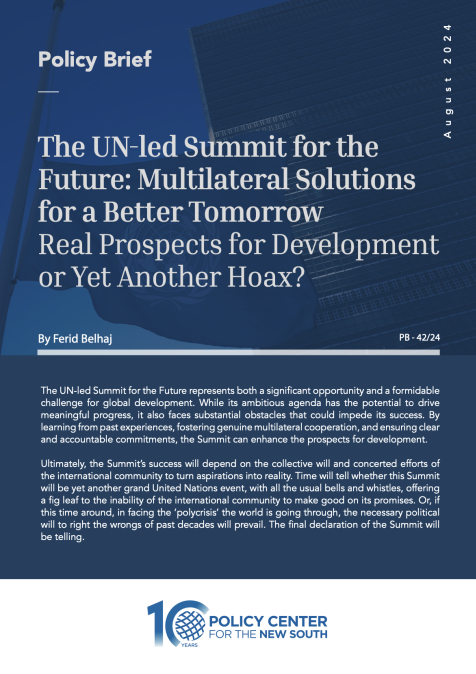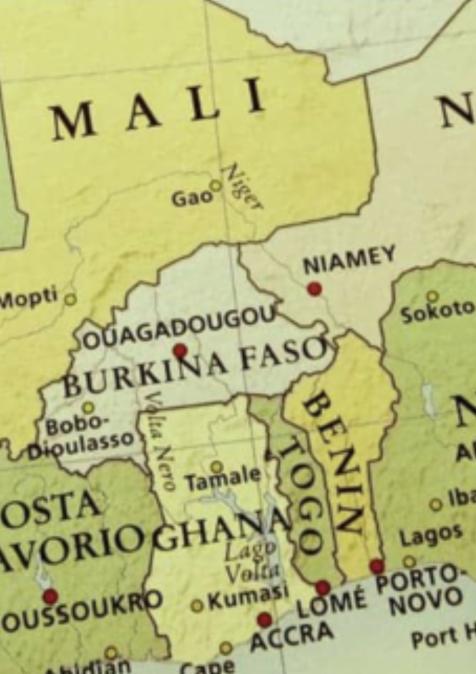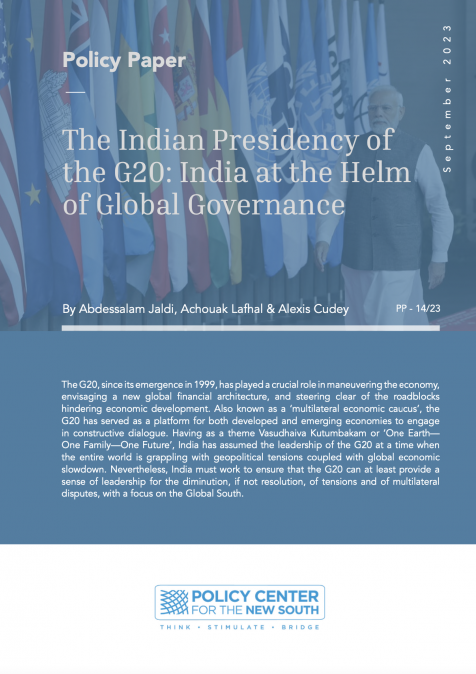Publications /
Policy Brief
The UN-led Summit for the Future represents both a significant opportunity and a formidable challenge for global development. While its ambitious agenda has the potential to drive meaningful progress, it also faces substantial obstacles that could impede its success. By learning from past experiences, fostering genuine multilateral cooperation, and ensuring clear and accountable commitments, the Summit can enhance the prospects for development.
Ultimately, the Summit’s success will depend on the collective will and concerted efforts of the international community to turn aspirations into reality. Time will tell whether this Summit will be yet another grand United Nations event, with all the usual bells and whistles, offering a fig leaf to the inability of the international community to make good on its promises. Or, if this time around, in facing the ‘polycrisis’ the world is going through, the necessary political will to right the wrongs of past decades will prevail. The final declaration of the Summit will be telling.
The United Nations Summit of the Future: Multilateral Solutions for a Better Tomorrow (The Summit) was first proposed by UN Secretary-General António Guterres in the Our Common Agenda report[1]. The report was his response to a call from UN Member States for ideas on how better to respond to current and future challenges.
The Summit will be held in September 2024 and is billed by SG Guterres as a “once-in-a-generation opportunity to reinvigorate global action, recommit to fundamental principles, and further develop the frameworks of multilateralism so they are fit for the future”.
The UN, often seen as the world’s foremost body for maintaining international peace and fostering global cooperation, has embarked once again on a new venture—. An ambitious initiative is set to address critical global issues. The upcoming UN Summit for the Future is viewed as a key moment for global development, with objectives including promoting sustainable development, enhancing global health security, and ensuring equitable access to technology. The Summit also aims to advance climate action, strengthen conflict resolution, uphold international law, bridge global inequalities, protect human rights, and foster inclusive economic growth.
By doing so, the Summit aspires to build a more resilient and just world order, responsive to the needs of future generations. Yet, skepticism abounds. The real challenge lies in translating these lofty goals into tangible outcomes.
This paper critically examines whether the UN-led Summit for the Future represents a genuine opportunity for global development or if it is poised to become yet another unfulfilled promise. The paper also suggests that the fundamental goal of any multilateral development strategy should be to address the interconnected challenges of youth, jobs, and human capital faced by many developing countries, which most of the world’s population is struggling with.
I- Historical Context and Summit Objectives
The United Nations has a storied history of summits and conferences, each with varying degrees of success. From the Earth Summit in 1992 to the Millennium Development Goals (MDGs) and the subsequent Sustainable Development Goals (SDGs), the UN has consistently attempted to galvanize international action to tackle global challenges. The Summit for the Future builds on these efforts, with a specific focus on preparing the world for the emerging and largely unpredictable challenges of the twenty-first century, the first quarter of which is already proving testing.
The primary objectives of the summit include:
1. Addressing Climate Change: Building on the Paris Agreement, a legally binding international treaty on climate change adopted in 2015 by 196 parties at the UN Climate Change Conference (COP21) in Paris, France; the Summit aims to enhance global commitments to reduce carbon emissions and foster sustainable practices.
2. Tackling Inequality: The Summit seeks to address economic and social disparities, aiming to create more equitable growth and development opportunities.
3. Managing Technological Disruption: With the rise of artificial intelligence, automation, and digital economies, the Summit intends to create frameworks for harnessing technological advancements while mitigating associated risks.
4. Strengthening Global Governance: The Summit will focus on reforming international institutions to better handle global crises and improve cooperation among nations.
Prospects for Development: Optimism and Potential
The Jobs, Knowledge, Human Capital Nexus
The focus on the jobs challenges facing the ever-growing young populations of developing countries, should indeed be at the forefront of the global agenda for the twenty-first century. With Africa’s youth population growing at an unprecedented rate—projected to reach nearly one billion by 2050—the need for sustainable job creation is both urgent and critical. This demographic surge, coupled with unsustainable youth unemployment rates rising to 50% in some regions of Africa, underscores the importance of a job-centric global action.
The World Bank has been playing a pivotal role in this endeavor and needs to do more. As a leading global financial institution, it has the capacity to drive investment in key sectors including agriculture, technology, and renewable energy, which are essential for generating sustainable jobs. By prioritizing Africa’s young people in its development programs, the World Bank can help ensure even more that this burgeoning population finds meaningful employment, thereby fostering economic growth and social stability.
On August 12, 2024, The World Bank Group announced the launch of the High-Level Advisory Council on Jobs, to be co-chaired by the President of the Republic of Singapore Tharman Shanmugaratnam, and former President of the Republic of Chile Michelle Bachelet. It is a new initiative to identify actionable policies and programs to address the looming jobs crisis in the Global South. The Bank states that “over the next 10 years, an unprecedented 1.2 billion young people in the Global South will become working age adults. Meanwhile, the job market is only expected to create 420 million jobs—leaving nearly 800 million without a clear path to prosperity. Though some young people will be in further education, their eventual entry into the labor market will add to this challenge”.
The Summit for the Future presents a unique opportunity to address and act on these challenges head-on and to push governments to engage in meaningful reforms to promote the much-needed environment for growth that is private-sector led and job-creating.
Knowledge and Human Capital as Drivers
The UN-led Summit for the Future has the potential to transform the ‘knowledge agenda’ into a cornerstone for sustainable development. By integrating education and youth empowerment, the Summit needs to bridge the gap between global knowledge resources and local development needs. The World Bank estimates that each additional year of schooling raises average annual GDP growth by 0.37%. Harnessing this potential requires targeted investments in digital infrastructure and educational reform, especially in developing nations where nearly 60% of the young population lacks access to quality education. To put these assessments into action, former World Bank president Jim Kim launched the Human Capital Project (HCP) in 2018, as a “global effort to accelerate more and better investments in people for greater equity and economic growth”. So far, the World Bank has committed over $26 billion to Human Capital Project-related programs globally. These investments are part of a broader effort to help countries improve their human capital outcomes, crucial for sustainable economic growth and poverty reduction. The initiative also includes the Human Capital Index, which ranks countries based on their investments in human capital, encouraging them to improve policies and outcomes in this area. The Summit is an opportunity to further emphasize this priority and stress the lack of progress in a large number of countries.
Moreover, the summit can encourage public-private partnerships that focus on skills training aligned with future job markets. According to the International Labour Organization, 90% of new jobs globally by 2030 will require digital skills. The Summit offers a platform to call for collaboration between governments, tech firms, and educational institutions to equip young people with the necessary skills to thrive in a digital economy. Knowledge drives development, and the Summit for the Future must emphasize inclusive education policies that prioritize marginalized young people. With over 258 million children out of school worldwide according to UNESCO data, the link between knowledge, education, and young people is not just a policy agenda but a critical pathway to achieving the Sustainable Development Goals (SDGs).
Enhanced Climate Action
The Summit’s emphasis on climate change reflects a critical and urgent need for global action. The potential for enhanced climate action is significant, particularly if major economies commit to more ambitious targets and concrete measures. The involvement of the private sector, civil society, and local governments could amplify these efforts, fostering a multi-stakeholder approach that leverages diverse resources and expertise.
Commitments to increase their climate ambitions made at the Dubai Climate Summit (COP28) by major economies, including the United States, China, and the European Union, are potentially remarkable. For instance, the United States committed to reducing its greenhouse gas emissions by 50%-52% below 2005 levels by 2030, while the European Union aimed to cut emissions by at least 55% by 2030 compared to 1990 levels. China, the world’s largest emitter, reiterated its commitment to peak carbon emissions before 2030 and achieve carbon neutrality by 2060. The focus on transitioning from coal to renewable energy was a significant part of these promises, with large-scale investments in solar, wind, and hydrogen technologies being highlighted.
The Dubai summit also saw numerous commitments from the private sector, emphasizing the role of businesses in driving climate action. Companies including Microsoft, Google, and Unilever announced initiatives to become carbon-neutral or even carbon-negative within the next decade. Microsoft, for instance, pledged to remove all the carbon it has emitted since its founding by 2050.
A strong focus was also confirmed on green finance and investments in sustainable technologies to align with the goals of the Paris Agreement, ensuring capital flows toward sustainable and low-carbon projects.
Public-private partnerships were highlighted as crucial for scaling up climate solutions. Initiatives such as the Mission Innovation platform brought together governments and private-sector leaders to accelerate the development and deployment of clean energy technologies through collaborative projects and shared knowledge.
Would the Summit bring all these pledges and commitments into an actionable and concrete set of realizations? Would convening it a few weeks before COP29 in Baku offer an opportunity for laying out an ambitious and complementary agenda for climate?
Economic and Social Inclusion
The Summit’s focus on inclusive growth and social protection mechanisms offers a promising pathway to lift millions out of poverty and reduce societal disparities. Central to this approach is the promotion of fair-trade practices, which aim to ensure that developing nations compete on an equal footing in the global marketplace.
Furthermore, equitable access to education is a cornerstone of this initiative, recognizing that education is a powerful tool for breaking the cycle of poverty and enabling individuals to realize their full potential. The Summit is also championing healthcare access, which is vital for building resilient communities and fostering long-term economic stability. By addressing these fundamental areas, the UN Summit for the Future can pave the way for more balanced and just development—through the promotion of a much-needed Human Capital agenda as outlined above, offering tangible benefits for those most in need, and creating a more equitable global society.
Technological Governance
The Summit’s goal of creating robust frameworks for technological innovation can lead to more ethical and inclusive technological development. This includes ensuring data privacy, cybersecurity, and the equitable distribution of technological benefits. This also highlights major challenges the Summit will have to identify, define, and address, including but not limited to economic inequality, the digital divide and skills gap, data privacy, cybersecurity, and a number of ethical considerations that need a firm and actionable regulatory framework. Addressing these challenges requires a multi-faceted approach, involving collaboration between governments, the private sector, civil society, and international organizations. As of now, and given the tremendous speed at which technologies, and notably artificial intelligence (AI), are advancing, one recent achievement is the first legally binding international treaty on AI, the Framework Convention on Artificial Intelligence, adopted on May 17, 2024, by the Council of Europe. The treaty aims to establish global standards for AI governance that ensure the technology is used responsibly and respects human rights, democracy, and the rule of law. It applies throughout the AI life cycle, from design and development, to use and decommissioning. Importantly, the treaty also takes a risk-based approach and is open to non-European countries. An important aspect of the treaty is that it includes mechanisms to oversee compliance with its obligations.
In the U.S., and while the country does have a few AI-related laws, they relate mostly to specific administrative matters within the federal government, offering little to no relevance outside the public sector. Such is the case for the AI Training Act. In China, another AI global powerhouse, the regulations are still provisional in nature and for now are framed within the ‘Interim Measures for the Management of Generative Artificial Intelligence Services’ (referred to as the ‘AI Measures’), which is the first administrative regulation on the management of Generative AI services, and which came into effect on August 15, 2023.
It’ll thus be interesting to monitor the negotiations for the Summit’s final declaration as it relates to this matter.
Reforming Global Institutions
The Summit’s call for strengthened global governance and the reform of international institutions resonates with the need for more effective and representative global cooperation. Enhanced mechanisms for conflict resolution, crisis management, and international law enforcement can lead to a more stable and cooperative international order.
However, achieving these goals hinges critically on the political will to reform International Financial Institutions (IFIs) and global financing bodies.
The IFIs, including the International Monetary Fund (IMF) and the World Bank, have long been the bedrock of global economic stability and development. Yet, their structures and policies have often been criticized for being outdated and disproportionately favoring the interests of developed nations. To address the pressing challenges of today—ranging from climate change to economic inequality—there is a compelling need to overhaul these institutions to reflect the current geopolitical and economic realities.
Reforming the IFIs requires a concerted effort from the global community, particularly from the major shareholders who wield significant influence. Political will is essential to undertake comprehensive reforms that ensure these institutions become more inclusive, transparent, and responsive to the needs of all member states. This involves revising voting rights, enhancing representation of emerging and developing economies, and adopting policies that promote sustainable and equitable growth.
Furthermore, global financing institutions must align their strategies with the SDGs. This includes prioritizing investments in green technologies, supporting initiatives that foster economic resilience, and ensuring that financial flows are directed towards projects that benefit the most vulnerable populations.
Without the political will to drive these reforms forward, the ambition to strengthen global governance and reform international institutions will remain unfulfilled. Leaders must demonstrate a genuine commitment to multilateralism and international cooperation, recognizing that a reformed global financial architecture is pivotal to achieving a more equitable and stable world order.
II- Skepticism and Challenges: The Hoax Narrative
Historical Precedents of Unfulfilled Promises
Critics argue that the UN’s history is replete with ambitious declarations and unfulfilled promises. The gap between rhetoric and action often undermines the credibility of such initiatives.
The Millennium Development Goals (MDGs), set out in 2000, were intended to address by 2015 critical global issues including poverty, hunger, disease, illiteracy, environmental degradation, and discrimination against women. While partly successful, the MDGs fell short in several areas, such as maternal health, education action, and sanitation.
The SDGs, launched in 2015 to build on the MDGs, encompass a broader range of issues, including economic growth, social inclusion, and environmental sustainability. However, critics argue that the SDGs face similar challenges, including financing—meeting the SDGs requires trillions of dollars annually, and funding gaps persist. Developing countries in particular struggle to mobilize the necessary resources. In the past few years, the World Bank and other IFIs have argued for the need to jump development assistance from billions to trillions, to no avail so far. An additional complication is that the SDGs comprise 17 goals and 169 targets, making tracking progress and ensuring accountability complex. Data gaps and inconsistent reporting undermine effective monitoring and therefore make the argument for mobilizing financing for effective outcomes all the more challenging. Finally, the implementation of the SDGs depends heavily on national governments’ commitments and political will. In many cases, competing priorities and lack of political stability hinder progress. The above complexities leading to skepticism about the effectiveness of subsequent UN-led initiatives such as the Sustainable Development Goals (SDGs), and now the Summit for the Future.
Digital Governance: Previous UN initiatives on internet governance, such as the World Summit on the Information Society (WSIS), were criticized for lack of concrete outcomes and limited implementation. As mentioned above, limited advances are being noted, mainly in the European rules-based framework, and the world is still in the very beginning of the journey.
Climate Change: Despite the Paris Agreement’s ambitious goals, and commitments made by signatories, global greenhouse gas emissions continue to rise, and the world is not on track to meet the target of limiting global warming to 1.5°C above pre-industrial levels. Many countries have failed to meet their nationally determined contributions (NDCs), and climate finance pledges remain unmet.
Global Health: Global health has been a key focus of international commitments over the past few decades, with various agreements and initiatives aimed at addressing widespread health issues. However, many of these commitments remain unfulfilled. One of the most prominent examples is the commitment to Universal Health Coverage (UHC), a goal enshrined in the SDGs.
The global response to pandemics also highlights the gap between commitments and reality. The COVID-19 pandemic exposed significant weaknesses in global health governance, including delays in vaccine distribution and inequities in access to medical resources.
Additionally, commitments to combat non-communicable diseases have fallen short.
Refugee Crisis: The Global Compact on Refugees, adopted in 2018, aimed to improve the international response to refugee situations. However, many host countries continue to struggle with inadequate support and resources, leading to prolonged refugee crises. Lebanon and Jordan provide stark examples of the challenges posed by unmet commitments. Both countries have shouldered a disproportionate burden, hosting millions of Syrian refugees since the outbreak of Syria’s civil war. Despite international promises of financial aid and support, and the creativity mustered by the World Bank with the creation of the Concessional Financing Facility in 2016, allowing refugee host countries to get cheap financing, both Lebanon and Jordan have received only a fraction of the necessary resources.
In Lebanon, which hosts the highest number of refugees per capita in the world, the strain on infrastructure, public services, and the economy has been immense. International pledges of financial assistance have often been delayed or only partially fulfilled, leaving Lebanon with inadequate resources to manage a refugee population that makes up over a quarter of its total population. This has exacerbated social tensions, increased poverty levels, and strained the country’s already fragile economy.
Jordan, too, has faced significant challenges. The country has taken in over 1.3 million Syrian refugees, which has put a tremendous strain on its water resources, education system, and healthcare infrastructure. Although international donors have provided some assistance, it has fallen short of the needs, leaving Jordan to cover the gaps. The Jordan Compact, an initiative aimed at providing jobs and education to Syrian refugees in exchange for international aid, has seen limited success because of insufficient funding and complex implementation challenges.
Political and Economic Realities
A few weeks ahead of its convening, the Summit faces significant geopolitical and economic challenges. Rising nationalism, geopolitical tensions, and economic rivalries among major powers could hinder collective action. The reluctance of some nations to commit to binding agreements and the diverging priorities of developed and developing countries pose substantial obstacles.
A perennial challenge for global summits is the implementation of agreed goals. Without robust mechanisms for accountability and follow-through, lofty commitments often remain on paper. Ensuring that nations adhere to their pledges and that progress is monitored effectively will be critical to the Summit’s success. Setting clear, measurable, and achievable goals will be crucial. Vague commitments and broad declarations should be avoided in favor of specific targets with defined timelines and accountability mechanisms. This will enable better tracking of progress and more effective implementation.
Regular monitoring, reporting, and independent evaluations can help track progress and hold stakeholders accountable. Transparency in decision-making processes and resource allocation can also build trust and credibility.
Addressing global challenges requires substantial financial and human resources. The COVID-19 pandemic strained national budgets and shifted priorities, potentially limiting the resources available for international development initiatives. Mobilizing adequate funding and ensuring efficient resource allocation will be crucial to achieve the Summit’s objectives. Securing adequate financial and human resources is critical for implementing the Summit’s goals. This includes mobilizing public- and private-sector funding, leveraging innovative financing mechanisms, and ensuring efficient resource allocation. International financial institutions, philanthropic organizations, and private investors can play a vital role in supporting the Summit’s initiatives.
References
- Belhaj, F. (2024). The Shift from Multilateralism to Plurilateralism: A Challenge for the Bretton Woods Institutions and the UN as They Turn 80? The Policy Center for the New South.
- Bostrom, N. (2014). Superintelligence: Paths, Dangers, Strategies. Oxford University Press.
- Brynjolfsson, E., & McAfee, A. (2014). The Second Machine Age: Work, Progress, and Prosperity in a Time of Brilliant Technologies. W.W. Norton & Company.
- Deaton, A. (2013). The Great Escape: Health, Wealth, and the Origins of Inequality. Princeton University Press.
- Dimitrov, R. S. (2023). The Paris Agreement on Climate Change: Analysis and Commentary. Oxford University Press.
- Filmer, D., & Fox, L. (2014). Youth Employment in Sub-Saharan Africa. World Bank.
- Frenk, J., & Moon, S. (2013). "Governance Challenges in Global Health." New England Journal of Medicine, 368(10), 936-942.
- Guterres, A. (2021). Our Common Agenda: Report of the Secretary-General. United Nations. Available at: UN Website.
- "The New AI Treaty: A Global Approach to Regulation." Reuters, 2024.
- "The Paris Agreement: Successes and Failures." BBC News, 2023.
- "The Syrian Refugee Crisis: A Broken Promise?" Al Jazeera, 2024.
- "Why Universal Health Coverage Remains Elusive." The Lancet, 2024.
- "Why the SDGs Are Failing and What Can Be Done." The Guardian, 2024.
- "The Global Health Crisis and the Role of the UN." The Washington Post, 2023.
- "The UN's Push for Inclusive Economic Growth." The New York Times, 2024.
- "The UN's Struggle with Internet Governance." The Financial Times, 2024.
- "Corporate Climate Pledges at COP28: Are They Enough?" The Financial Times, 2023.
- Mahbubani, K. (2024). "The Case for Reforming the IMF and World Bank." The Economist.
- Radelet, S. (2015). The Great Surge: The Ascent of the Developing World. Simon & Schuster.
- Rodrik, D. (2011). The Globalization Paradox: Democracy and the Future of the World Economy. W.W. Norton & Company.
- Sachs, J. D. (2015). The Age of Sustainable Development. Columbia University Press.
- Stiglitz, J. E. (2018). Globalization and Its Discontents Revisited: Anti-Globalization in the Era of Trump. W.W. Norton & Company.
- United Nations Framework Convention on Climate Change (UNFCCC). (2015). The Paris Agreement. Available at: UNFCCC Website.
- Weiss, T. G., & Daws, S. (2018). The Oxford Handbook on the United Nations. Oxford University Press.
- World Bank. (2018). The Human Capital Project. Available at: World Bank Website.
[1] United Nations, "Our Common Agenda – Report of the Secretary-General," 2021, New York, NY, 10017, United States of America









